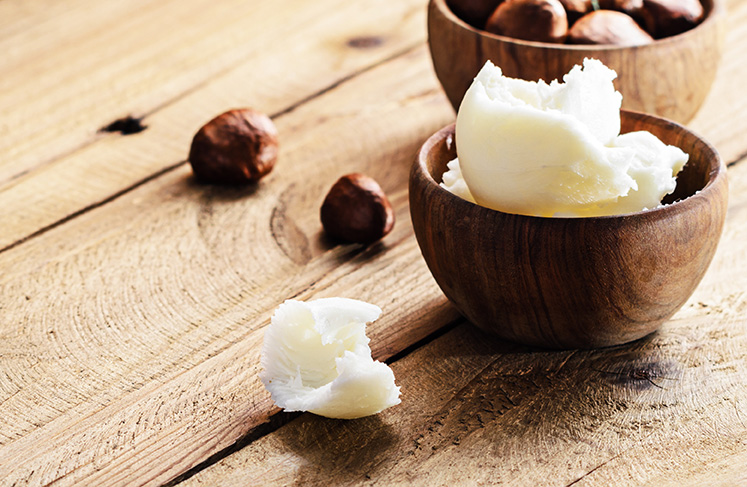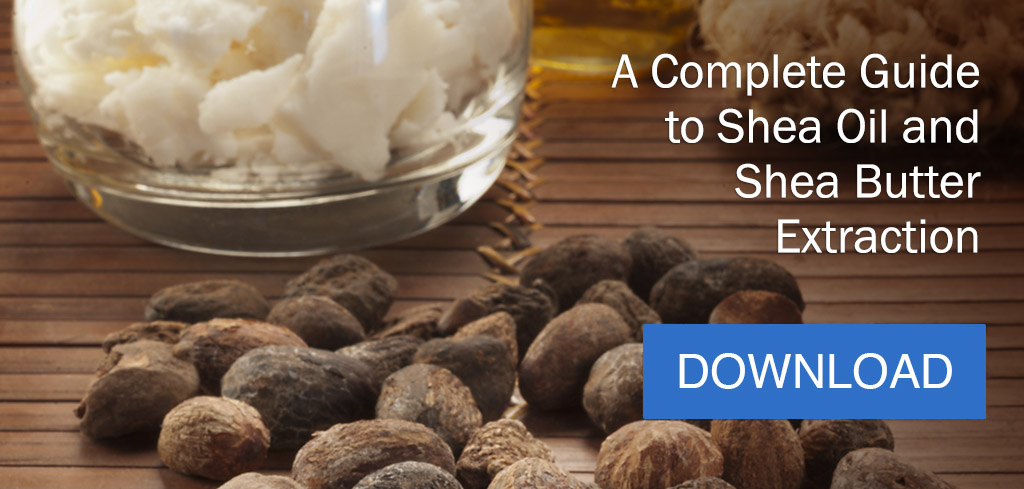
Although it only grows in a limited swath of sub-Saharan African parklands, the wild shea tree supplies the entire world with enough shea nuts to meet the growing demand for both shea oil and shea butter. African civilizations have been processing shea nuts by hand for centuries, using tedious traditional methods of shea butter extraction to produce a valuable fat used to make food, skincare products, and healing ointments.
Today, the global shea market represents an estimated value of $2.75 billion, which is set to double within the next ten years to exceed $5.5 billion by 2033. Africa produces approximately 1,760,000 metric tons (MT) of raw shea nuts a year, and historically, most of this stayed within the African continent to supply domestic demand. The shea export market traditionally traded raw shea kernels rather than shea butter or other finished products.
However, as shea applications have evolved and processing methods have improved, shea butter exports have increased as producing countries invest in more advanced equipment. As the global demand for shea products grows, new processing plants are setting up shop, searching for more efficient shea oil and shea butter extraction methods to supply the entire world.
Pre-processing shea nuts
As Africa’s second most important oil crop, shea trees sustain millions of indigenous women who gather fallen fruit and prepare the nuts to be processed into shea butter. As a vital income source for these underserved populations, shea has earned the nickname “women’s gold.”
Wild shea trees take at least 20 years to reach maturity, then produce about 20 kilograms of nuts each year for 200 years. Ripe fruit fall from the trees when mature, supplying approximately 800,000 tons of nuts that local women collect and clean.
Removing the nuts from these fallen fruits and preparing the kernels for processing involves several tedious, time-consuming steps, including:
- De-pulping to remove the fleshy fruit surround surrounding the nut either by manually peeling it off or fermenting the fruit in heaps to dissolve it.
- Boiling at 212-220 degrees Fahrenheit for about 30-45 minutes to soften the nuts, releasing the oil inside and cleaning off any remaining pulp, deactivating harmful enzymes.
- Drying in the sun or in an oven for several days to reduce the moisture content and prevent mold during storage.
- De-husking to remove the shell by cracking the kernel then blowing the shells off with a fan or winnowing machine.
Dried, shelled shea nut kernels can be stored or sold at this point in the process. Or the women may process the kernels themselves using traditional shea butter extraction methods.
Also read: Capitalizing on Specialty Oils and Fats with the Anderson Super Duo
Shea butter extraction
Traditionally, African women used simple water extraction to produce shea butter in their villages. They would pound the kernels in a pestle and then add water to create a paste that they’d knead by hand for at least half an hour. Next, this paste is boiled to separate the fat from the solid seed residue, and the oil is skimmed off the top and cooled to produce natural shea butter.
The entire wet extraction process takes up to 30 hours of manual labor, but with so many uncontrollable factors, it has the lowest yields and highest variability. This inefficient, inexpensive extraction method leaves about 23% of the fat behind, only yielding about 35% of the oil. As a result, many shea producers are adopting more mechanized solutions to improve quality and yield.
Larger processors use mechanical extraction equipment to recover more oil efficiently. Screw press expellers physically crush the shea kernels to squeeze out shea oil from the solid meal, which exits the expeller as a cake. Since shea contains such high concentrations of fat (at least 40% by weight), most processors send this kernel cake through a second press to squeeze out as much oil as possible, reducing residual oil levels to about 14-16%.
However, the unique dual-press design of the Anderson Super Duo™ Series Expeller® efficiently crushes the material twice in a single pass, with the torque to minimize residual oils and maximize shea oil yields.
Alternatively, some processors feed the de-oiled cake from the second press to a solvent extraction plant to chemically extract the remaining oil, leaving as little as 2% residual oil. This process uses a solvent like hexane to chemically dissolve the oil from the rest of the kernel and then process both byproducts to remove the remaining solvent.
While this method is the most effective at achieving maximum oil yields, the chemicals are expensive and potentially hazardous, raising health and environmental concerns. For these reasons, solvent extraction is generally not preferred for shea butter extraction—especially in food and cosmetic markets where consumers seek natural, organic ingredients.
What is shea oil?
Traditional water extraction, mechanical expeller pressing, and solvent extraction yield shea butter. So, what is shea oil, how is it extracted, and how does it differ from shea butter extraction?
Raw shea butter has a nutty aroma, a yellowish color, and a thick creamy consistency. After extraction, this raw shea butter is often refined, bleached, and deodorized to produce clear, odorless, refined shea butter. These refining processes may also remove some of shea’s beneficial bioactive compounds and unwanted colors and odors.
Once refined, shea butter can be fractionated into two parts: a creamy fat known as shea stearin and a liquid oil called shea olein—otherwise known as shea oil.
Fractionation separates these two unique components using either a chemical reagent or physical methods like centrifugation. This process produces two distinct products with unique applications:
- Shea stearin is often used as an alternative to cocoa butter when making chocolates and other creamy confections like ice creams, sauces, and spreads.
- Shea olein, or shea oil, is used extensively in cosmetic formulations as an effective emollient and a rich source of antioxidants. Shea oil is used in personal care products formulated for both skin and hair because it nourishes, moisturizes, repairs, and protects from damage.
Crude shea butter contains a fairly balanced concentration of oleic acid (46%), a monounsaturated fatty acid, and stearic acid (43%), a saturated fat. This composition contributes to its creamy texture. However, the fractionation process alters this fat profile so that shea oil contains about 59% oleic acid and only 27% stearic acid, which makes it more liquid at ambient temperatures
Shea oil growth potential
Although the shea industry comprises a relatively smaller market than other commodity oilseeds and nuts, shea’s steady popularity and unique properties are fueling its growth trajectory worldwide.
As the applications for shea oil and other byproducts continue to expand, while shea oil and shea butter extraction methods evolve, processors must continue to increase their capacity, quality, and efficiency. Processing plants can tap into massive profits in this market by optimizing methods and machinery to produce the highest quality shea products.
With over a century of experience processing unique nuts and oilseeds around the world, Anderson International can provide both the equipment and the expertise needed to succeed in this space. To learn more about the processing steps and opportunities surrounding shea oil and shea butter extraction, contact us today.
